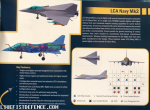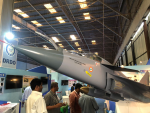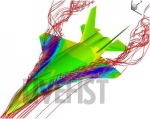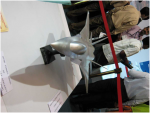India’s DRDO To Ditch LCA Navy Mk2 For Cleansheet Twin-Engine Jet Design
By Shiv Aroor.
Nov 20 2019, 10:47 am

A new twin-engine naval fighter design proposal is taking shape at India’s principal combat aircraft design house in Bengaluru to supply the Indian Navy with a future fighter for its aircraft carriers. The proposed fighter, with officially stated plans for a first flight by 2026, effectively shelves the Mk.2 version of the single-engine naval Light Combat Aircraft (N-LCA).
The proposal is a dramatic shift in plans by the DRDO-administered Aeronautical Development Agency (ADA), which until as recently as February, had been fine-tuning design changes on the LCA Navy Mk.2. Plans on the new jet design were first revealed earlier this week on Delhi Defence Review here.
The proposal, intended as a convergence of work done thus far on the LCA Navy Mk.2 and the twin engine design studies on the concept fifth generation AMCA stealth fighter, has an ambitious deadline right out the door.
The top leadership of ADA told
Livefist on Tuesday, “
The Indian Navy is looking for a twin-engine deck based fighter in lieu of the LCA Navy Mk.2. With confidence generated from AMCA design, we have developed twin engine competence. Hence configuration is currently being worked out. This is being targeted as a replacement for the MiG-29K with a first flight by 2026.”

The baseline LCA Navy is currently in flight test, and has completed a series of arrested landings this year at the Shore-based Test Facility in Goa. The proposed Mk.2 version of the LCA Navy, borne from the need from a higher performance fighter, was envisaged as a jet with a more powerful engine, increased internal fuel and weapons carrying capability, better mission performance and maintainability. In February this year, Livefist posted the first pictures of significant changes to the LCA Navy Mk.2 design, including the addition of tailplanes, larger wings and tweaked engine intakes:

The decision to curtail plans on the LCA Navy Mk.2 and instead pursue a twin-engine design isn’t surprising. The Indian Navy, while consistently supportive of the LCA Navy program, has made it clear it needs twin-engine fighters for its carrier decks. A prospective future fighter selection contest for 57 such aircraft is likely to be a fight between two twin-engine jets — the Rafale and Boeing’s F/A-18 Super Hornet.
These are embryonic days for the new proposal, but the ADA leadership’s suggestion that the new jet will be proposed as a MiG-29K replacement indicates it will be built as a STOBAR jet for operations off the INS Vikramaditya and first Vikrant-class aircraft carriers. A first flight by 2026 also indicates the DRDO is setting itself a a very tight deadline for the full design and prototyping phase. The ADA is, however, confident that it can navigate this critical path diligently.
 LCA Navy Mk.1 in flight test in 2018
LCA Navy Mk.1 in flight test in 2018
“
We have all the elements required from both projects (LCA Navy and AMCA) to assemble the new design,” says the ADA leadership. “
We are also equipped with knowledge of the pitfalls in the design and prototyping phase from past projects, so we have an adequate level of confidence. The bigger picture is that the next deck-based fighter of the Indian Navy should be an Indian design.”
The LCA Tejas is already in service with the Indian Air Force’s 45 Squadron in Sulur, Tamil Nadu, with more aircraft being inducted at a steady rate. The IAF will operate 123 aircraft in the Mk.1 and improved Mk.1A configurations. The LCA Tejas Mk.2 was revealed earlier this year in a new avatar, christened the Medium Weight Fighter (MWF), with the notable addition of canard foreplanes and a generally meatier frame. This will remain a single-engine fighter design, albeit with the baseline LCA’s F404 engine replaced with the more powerful F414.
 The Medium Weight Fighter, ealier LCA Tejas Mk.2
The Medium Weight Fighter, ealier LCA Tejas Mk.2
While the project is still only a proposal, Livefist understands the Indian Navy has shown willingness to support the twin engine carrier fighter path, especially since it gives the navy a chance for closure on the LCA Navy, a project that has had dramatic ups and downs through the ongoing development cycle. The LCA Navy’srecent flight test successes come in the wake of steady turbulence, including a fight for the project’s very survival.
With all the several variables, here’s what we can say with reasonable certainty:
The new design will be a twin-engined version of the LCA Navy Mk.2. While this will clearly involve major airframe changes, it almost definitely won’t go the AMCA way. The latter is a heavier (and purpose built stealth) fighter design, and while a naval AMCA has been part of overall plans, the new twin engine jet will likely seek to only incorporate twin-engine configuration studies gleaned on the AMCA program. While the LCA Navy Mk.2 effectively ends with this proposal, plans for a navalised AMCA theoretically continue. It appears likely that the new jet will be designed, like the AMCA, with a twin F414 engine configuration in mind.
As with all indigenous projects, the Indian Navy will be hoping that ambitious timelines don’t disrupt existing modernisation plans. As things stand, the newly proposed twin-engine fighter will likely be pursued parallel to the intended acquisition of 57 CATOBAR fighters for the proposed Vishal-class flat-top carriers.
https://www.livefistdefence.com/201...k2-for-cleansheet-twin-engine-jet-design.html


















